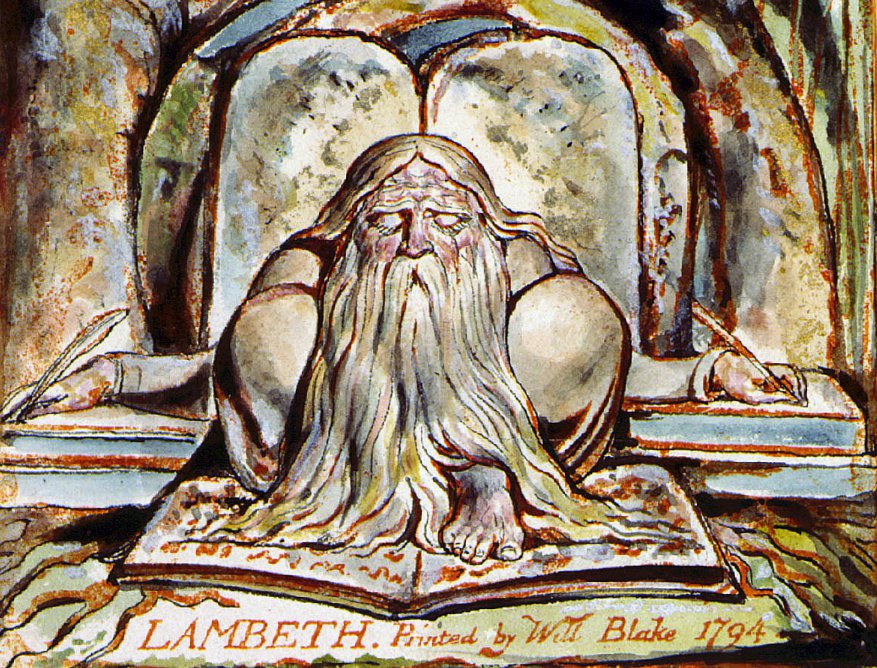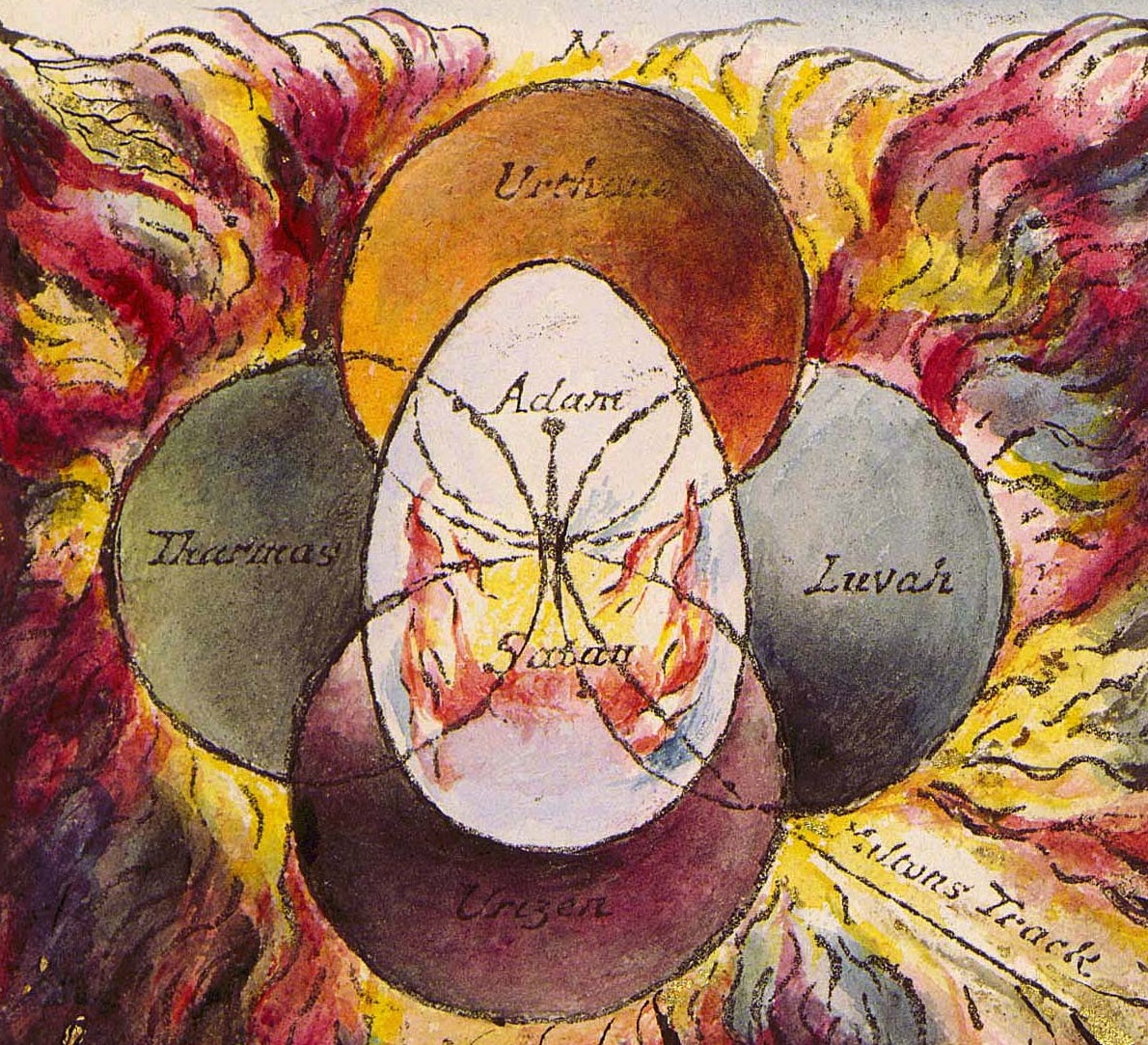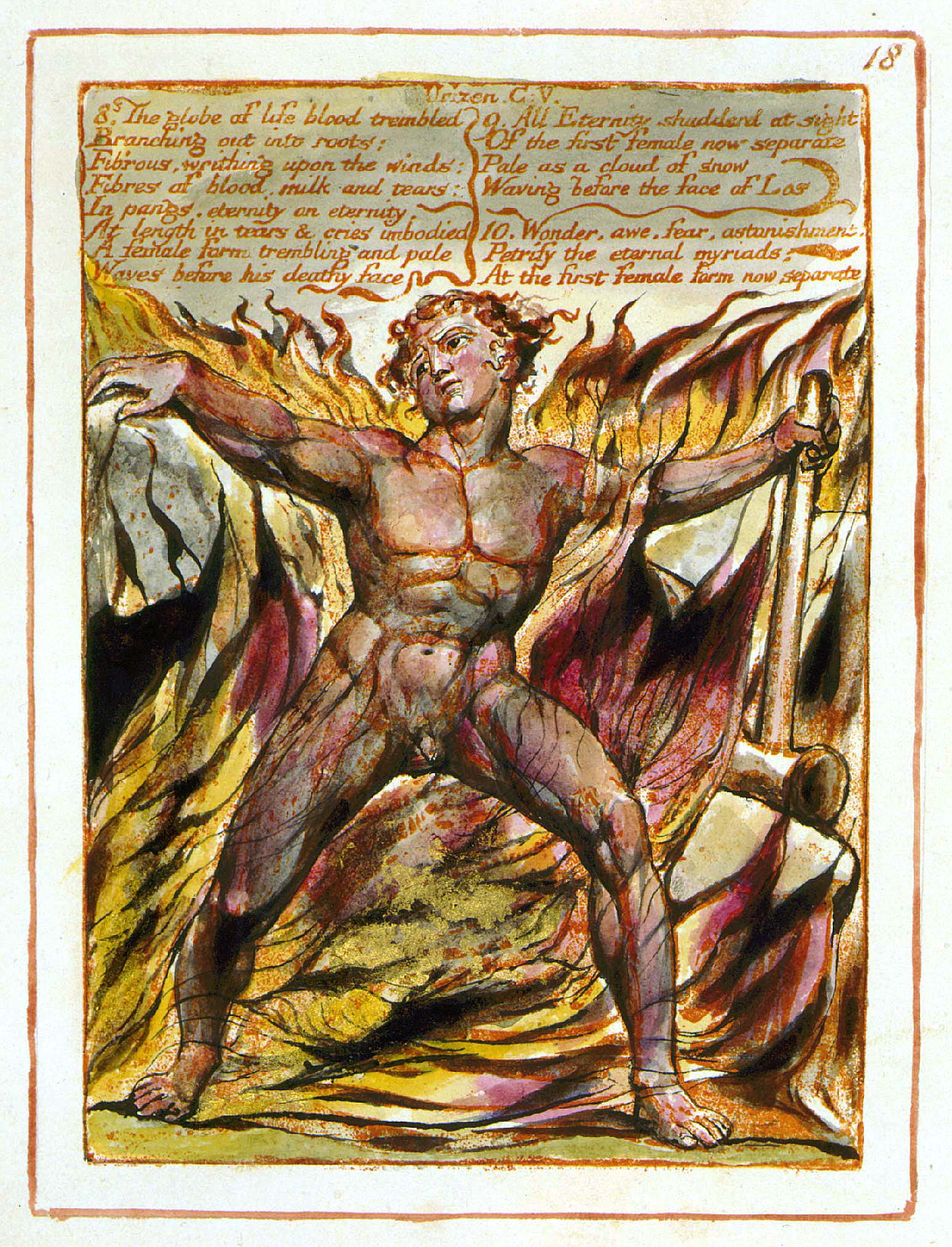|
Ahania
Ahania is the Emanation, or female counterpart, of Urizen, Zoas of reason, in William Blake's mythology. She is the representation of pleasure and the desire for intelligence. Although Urizen casts her out as being the manifestation of sin, she is actually an essential component in Blake's system to achieving Divine Wisdom. She is a figure of the goddess of wisdom. It is through her that the sons and daughters of Urizen are born. In the original myth, her son Fuzon rebels against his father and is responsible for separating Urizen and Ahania. In his later version, Ahania is separated from Urizen after he believes that she is sinful. Character Ahania represents pleasure and is connected to the Zoas Urizen, who represents reason. They are divided because Urizen is unable to understand the necessity of pleasure for the mind. In Blake's early myth, Ahania and Urizen are united until their son Fuzon separates the two by cutting his father's loins apart. She is labeled as Sin by Urizen ... [...More Info...] [...Related Items...] OR: [Wikipedia] [Google] [Baidu] |
The Book Of Ahania
''The Book of Ahania'' is one of the English poet William Blake's prophetic books. It was published in 1795, illustrated by Blake's own plates. The poem of the book consists of six chapters. The content concerns Fuzon, a son of Urizen, a ''Zoa'' or major aspect in Blake's mythology. Ahania of the title is Urizen's female counterpart. Background During autumn 1790, Blake moved to Lambeth, Surrey. He had a studio at the new house that he used while writing his what were later called his "Lambeth Books", which included ''The Book of Ahania'' in 1795. Like the others under the title, all aspects of the work, including the composition of the designs, the printing of them, the colouring of them, and the selling of them, happened at his home. ''The Book of Ahania'' was one of the few works that Blake describes as "illuminated printing", one of his colour printed works with the coloured ink being placed on the copperplate before printed. Both ''The Book of Los'' and ''The Book of Aha ... [...More Info...] [...Related Items...] OR: [Wikipedia] [Google] [Baidu] |
Urizen And Ahania
In the mythology of William Blake, Urizen () is the embodiment of conventional reason and law. He is usually depicted as a bearded old man; he sometimes bears architect's tools, to create and constrain the universe; or nets, with which he ensnares people in webs of law and conventional society. Originally, Urizen represented one half of a two-part system, with him representing reason and Los, his opposition, representing imagination. In Blake's reworking of his mythic system, Urizen is one of the four ''Zoas'' that result from the division of the primordial man, Albion, and he continues to represent reason. He has an Emanation, or paired female equivalent, Ahania, who stands for Pleasure. In Blake's myth, Urizen is joined by many daughters with three representing aspects of the body. He is also joined by many sons, with four representing the four elements. These sons join in rebellion against their father but are later united in the Last Judgment. In many of Blake's books, Ur ... [...More Info...] [...Related Items...] OR: [Wikipedia] [Google] [Baidu] |
Urizen
In the mythology of William Blake, Urizen () is the embodiment of conventional reason and law. He is usually depicted as a bearded old man; he sometimes bears architect's tools, to create and constrain the universe; or nets, with which he ensnares people in webs of law and conventional society. Originally, Urizen represented one half of a two-part system, with him representing reason and Los, his opposition, representing imagination. In Blake's reworking of his mythic system, Urizen is one of the four ''Zoas'' that result from the division of the primordial man, Albion, and he continues to represent reason. He has an Emanation, or paired female equivalent, Ahania, who stands for Pleasure. In Blake's myth, Urizen is joined by many daughters with three representing aspects of the body. He is also joined by many sons, with four representing the four elements. These sons join in rebellion against their father but are later united in the Last Judgment. In many of Blake's books, Urize ... [...More Info...] [...Related Items...] OR: [Wikipedia] [Google] [Baidu] |
Fuzon (Blake)
In the mythological writings of William Blake, Fuzon is the fourth and final son of Urizen, associated with the classical element of fire. In ''The Book of Ahania'' he fights Urizen for control of the world. Identifications S. Foster Damon in his '' Blake Dictionary'' states that Fuzon represents fire in the four classical elements. His siblings representing the other elements are Utha, Grodna and Thiriel. Damon notes parallels in Greek mythology with the castration of Uranus, by Cronus (Saturn); and in the Freudian Oedipus complex. David V. Erdman proposed an identification of Fuzon with Robespierre; Harold Bloom supported it as "probable" in "historical allegory", adding that in "moral allegory" he is a "Promethean version of Moses". Northrop Frye finds a connection of Fuzon with the biblical Absalom. Fuzon the rebel Fuzon appears as a rebel in ''The Book of Ahania'', a sequel of sorts to ''The Book of Urizen''. Hobson writes If the Fuzon material in ''Ahania'' is read cont ... [...More Info...] [...Related Items...] OR: [Wikipedia] [Google] [Baidu] |
Vala, Or The Four Zoas
''Vala, or The Four Zoas'' is one of the uncompleted prophetic books by the English poet William Blake, begun in 1797. The eponymous main characters of the book are the Four Zoas (Urthona, Urizen, Luvah and Tharmas), who were created by the fall of Albion in Blake's mythology. It consists of nine books, referred to as "nights". These outline the interactions of the Zoas, their fallen forms and their Emanations. Blake intended the book to be a summation of his mythic universe but, dissatisfied, he abandoned the effort in 1807, leaving the poem in a rough draft and its engraving unfinished. The text of the poem was first published, with only a small portion of the accompanying illustrations, in 1893, by the Irish poet W. B. Yeats and his collaborator, the English writer and poet Edwin John Ellis, in their three-volume book '' The Works of William Blake''. Background Blake began working on ''Vala, or The Death and Judgement of the Eternal Man: A Dream of Nine Nights'' while he wa ... [...More Info...] [...Related Items...] OR: [Wikipedia] [Google] [Baidu] |
William Blake's Mythology
The prophetic books of the English poet and artist William Blake contain an invented mythology, in which Blake worked to encode his spiritual and political ideas into a prophecy for a new age. This desire to recreate the cosmos is the heart of his work and his psychology. His myths often described the struggle between enlightenment and free love on the one hand, and restrictive education and morals on the other. Sources Among Blake's inspirations were John Milton's ''Paradise Lost'' and ''Paradise Regained'', the visions of Emanuel Swedenborg and the near-cabalistic writings of Jakob Böhme. Blake also included his own interpretations of druidism and paganism. The Fall of Albion The longest elaboration of this private myth-cycle was also his longest poem, '' The Four Zoas: The Death and Judgment of Albion The Ancient Man'', written in the late 1790s but left in manuscript form at the time of his death. In this work, Blake traces the fall of Albion, who was "originally fourfold b ... [...More Info...] [...Related Items...] OR: [Wikipedia] [Google] [Baidu] |
Enion
In the mythological writings of William Blake, Enion is an Emanation/mate of Tharmas, one of the four Zoas, who were created when Albion, the primordial man, was divided fourfold. She represents sexuality and sexual urges while Tharmas represents sensation. In her fallen aspect, she is a wailing woman that is filled with jealousy. After the Final Judgment, she is reunited with Tharmas and able to experience an idealised sexual union. Character Enion is an Emanation, a female essence that is part of one of the divine Four Zoas. She is connected to Tharmas, who is the western and water based Zoas. He is connected to the senses and to the body, and her aspect is sexual desire. It is possible that her name comes from letters used in Enitharmon's name, with Tharmas being the middle portion of the name and hers representing the rest. Tharmas represents a unity within the spirit, and, when Enion is separated from him, she becomes the image of the earth mother. Enion has the power to genera ... [...More Info...] [...Related Items...] OR: [Wikipedia] [Google] [Baidu] |
Orc (Blake)
Orc is a proper name for one of the characters in the complex mythology of William Blake. A fallen figure, Orc is the embodiment of rebellion, and stands opposed to Urizen, the embodiment of tradition. In Blake's illuminated book ''America a Prophecy'', Orc is described by his mythic opponent, "Albion's Angel" as the "Lover of Wild Rebellion, and transgressor of God's Law". He symbolizes the spirit of rebellion and freedom, which provoked the French Revolution. Background The name Orc is possibly an anagram of the word ''cor'' (heart), in that he was stated in Blake's myth to be born of Enitharmon's heart, or ''orca'' (whale) because he sometimes takes the form of a whale. Orcus is also the Latin word for Hell, and Orc is presented as a rebellious, Luciferian character. He was created to serve as Blake's analysis of the revolutions in the United States and France. Character In Blake's myth, Orc is seen as the first child of Los with Enitharmon and sometimes either replaced in ... [...More Info...] [...Related Items...] OR: [Wikipedia] [Google] [Baidu] |
Jerusalem The Emanation Of The Giant Albion
''Jerusalem'', subtitled ''The Emanation of the Giant Albion'' (1804–1820, with additions made even later), is the last, longest and greatest in scope of the prophetic books written and illustrated by the English poet, artist and engraver William Blake. Etched in handwriting, accompanied by small sketches, marginal figures and huge full-plate illustrations, it has been described as "visionary theatre". The poet himself believed it was his masterpiece and it has been said that "of all Blake's illuminated epics, this is by far the most public and accessible". Nonetheless, only six copies were printed in Blake's lifetime and the book, like all of Blake's prophetic works, was all but ignored by his contemporaries. The lyric to the famous hymn ''Jerusalem'' (text also by Blake, with music by Sir Hubert Parry) is not connected to this poem. It is in fact taken from the preface to another of Blake's "prophetic books", ''Milton''. Production technique The poem, which was produced be ... [...More Info...] [...Related Items...] OR: [Wikipedia] [Google] [Baidu] |
Emanationism
Emanationism is an idea in the cosmology or cosmogony of certain religious or philosophical systems. Emanation, from the Latin ''emanare'' meaning "to flow from" or "to pour forth or out of", is the mode by which all things are derived from the first reality, or principle. All things are derived from the first reality or perfect God by steps of degradation to lesser degrees of the first reality or God, and at every step the emanating beings are less pure, less perfect, less divine. Emanationism is a transcendent principle from which everything is derived, and is opposed to both creationism (wherein the universe is created by a sentient God who is separate from creation) and materialism (which posits no underlying subjective and/or ontological nature behind phenomena being immanent). Origins Emanationism is a cosmological theory which asserts that all things "flow" from an underlying principle or reality, usually called the Absolute or Godhead. Any teachings which involve emanati ... [...More Info...] [...Related Items...] OR: [Wikipedia] [Google] [Baidu] |
Goddess Of Wisdom
A knowledge deity is a deity in mythology associated with knowledge, wisdom, or intelligence. Ancient Egyptian mythology * Neith, goddess sometimes associated with wisdom * Thoth, originally a moon deity, later became the god of knowledge and wisdom and the scribe of the gods * Sia, the deification of wisdom * Isis, goddess of wisdom, magic and kingship. She was said to be "more clever than a million gods". * Seshat, goddess of wisdom, knowledge, and writing. Scribe of the gods. Credited with the invention of writing and the alphabet. Later demoted to consort of Thoth. Armenian mythology * Anahit, goddess of wisdom * Tir, the god of written language, schooling, rhetoric, wisdom, and the arts Aztec mythology * Quetzalcoatl, god of the winds, art, culture, and wisdom, as well as the patron god of learning and knowledge. Caribbean mythology * Papa Legba, loa of speech, communication, understanding, and guardian of crossroads Celtic mythology * Ogma, a figure from Irish and Sco ... [...More Info...] [...Related Items...] OR: [Wikipedia] [Google] [Baidu] |
Los (Blake)
In the mythological writings of William Blake, Los is the fallen (earthly or human) form of Urthona, one of the four Zoas. He is referred to as the "eternal prophet" and creates the visionary city of Golgonooza. Los is regularly described as a smith, beating with his hammer on a forge, which is metaphorically connected to the beating of the human heart. The bellows of his forge are the human lungs. Los's emanation, Enitharmon, represents spiritual beauty and embodies pity, but at the same time creates the spatial aspect of the fallen world, weaving bodies for men and creating sexual strife through her insistence upon chastity. In the ''Book of Urizen'' (1794), Los and Enitharmon have a child, Orc, who is the embodiment of the spirit of revolution. The name ''Los'' is, by common critical acceptance, an anagram of '' Sol'', the Latin word for "sun". ''Los'' is also the plural form of ''El'', an ancient Hebrew deity. Such innovations are common in many of Blake's prophetic poems. B ... [...More Info...] [...Related Items...] OR: [Wikipedia] [Google] [Baidu] |


_Detail.jpg)





